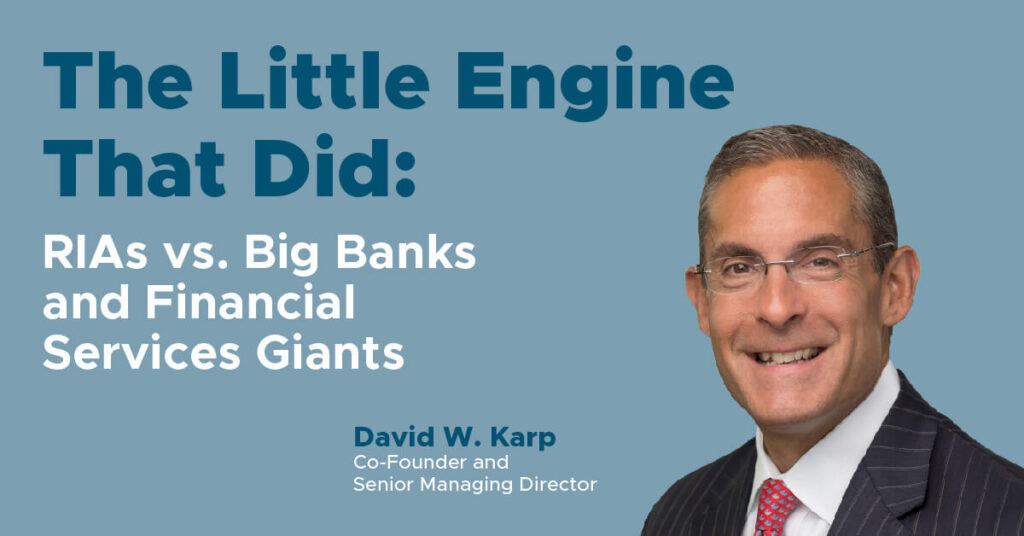
By David W. Karp, Co-Founder and Senior Managing Director
It’s a case of David beating Goliath (pardon the unintended third-person reference). What do I mean by that? In the past twenty years, the registered investment advisor (RIA) industry has undergone a remarkable transformation. We are now offering a comprehensive array of institutional-grade investment solutions and services that surpass even the capabilities of industry behemoths. How is that possible? In essence, the RIA can serve as every bank, brokerage, or wirehouse, accessing their products and solutions without the inherent conflicts and misalignments. A true fiduciary should be agnostic of the source of said solution and solely be focused on delivering results for the client.
In the world of financial services and capital markets, the industry has evolved to where the firms have origination, as well as distribution, which flows through advisors. But increasingly, these offerings are not necessarily about serving clients – they have become a tool for generating incremental revenue above advisory fees. In some cases, it’s less about delivering real value and more about creating a “built-in cover charge” for access to these offerings. This dynamic raises an important question: Are these strategies truly in the best interest of clients, or are they simply another way for firms to extract revenue at client expense?
Unrestricted Access to Explore Solutions
Traditional financial institutions have historically operated with limited offerings, often constrained by corporate incentives and “pay-to-play” arrangements. These structures enhance firm profitability, creating inefficiencies, aka costs, that ultimately reduce returns for clients. In contrast, independent firms boast a diverse pool of highly competent, experienced professionals that can leverage, without internal restrictions, the universe of investment firms, large and small – this enables the advisor to craft a bespoke solution precisely tailored to each individual client’s personal set of needs and objectives. All without the weight of internal bureaucracy, RIAs are able to curate investments based solely on their merit, often delivering better economics by avoiding unnecessary layers of friction and cost. In essence, there are fewer mouths to feed across the organization and a true fiduciary should not receive any embedded economics in or from that offering.
For managers, it’s not just about advising clients, it’s about generating revenue. Whether it’s by steering assets into proprietary money markets, ensuring their trading desks take a cut, or pushing structured products through their distribution channels, revenue streams stack up far beyond the advisory fee. An RIA, or true fiduciary, is a service provider, while the traditional incumbents, like big banks, brokerages, and wirehouses are asset accumulators that are building a pool into which they can distribute their products, services, and solutions to generate ancillary revenue streams.
Lower Costs = Higher Returns
One of the key differences between independent firms and larger institutions lies in their cost structures. Large financial institutions often layer on fees, whether for access to investment platforms, trading desks, or internal management. These fees impair returns. True fiduciary RIAs, on the other hand, focus on minimizing costs, which inherently maximize client returns. By deriving zero benefit from a client paying a partner, firm, or solution more than they should – eliminating revenue-sharing agreements, negotiating lower management fees, establishing leaner profit-and-loss structures, and not participating in the profit structures of larger firms (mark ups, mark downs, spreads, etc.) – we have created an incentive to fight for the client and drive lower costs. Fact: Lower costs drive higher returns.
Compensation for a true fiduciary advisor is not driven by the opacity of hidden revenue streams and fees – as a service provider, it is tied exclusively to the advisory fee the client transparently pays. This structure fosters a relationship built on transparency and trust, where the firm’s success is directly linked to client satisfaction and outcomes. How is that the case? Because it should be the only source of revenue for the advisor. Instead of pushing products and solutions that maximize firm revenue and profitability, RIAs prioritize delivering real value. While much of the financial industry has evolved into one where institutions focus on what they can extract out of clients (revenue streams, hidden fees), the RIA approach stands apart by focusing on what they can provide (service, performance, conflict-free advice, alignment).
The Rise of the RIA
The financial industry is at a pivotal moment. Clients are increasingly seeking firms that align their interests, prioritize cost efficiency, and deliver world-class investment solutions, performance, and service. With advancements in technology and the capital markets, RIAs can now offer institutional-quality solutions to a broader audience, providing access to top-tier investments without the overhead of traditional institutions. These smaller, independent firms have the incentive to focus on streamlining operations, minimizing fees, and focusing on performance-based results. By moving the client closer to the investment and eliminating unnecessary intermediaries (technology and scale provide direct access to marquee managers on advantageous terms), RIAs create an environment where both clients and advisors thrive. The incentive is clear: when clients succeed, so does the advisor.
You may ask: “How can an RIA or independent firm compete with the scale of institutional financial giants and wirehouses?” The answer lies in the numbers. Independent firms have a stronger incentive to control costs, which equates to higher returns. All of these large, mega-financial institutions have set up direct service networks and teams to service the RIA channel who directly represents their underlying clients. They are now offering the very same platforms to RIAs serving clients as they do to proprietary clients of their own. The evolution of the industry has resulted in product origination and distribution becoming bifurcated. The origination teams simply want to originate, they are often agnostic as to whom. The RIA has become the target client in the wealth management industry representing their clients.
RIAs have become some of the largest clients of the major financial institutions, driving significant capital and shaping the way these organizations compete for business. Their size and scale have created a unique opportunity. These firms are now competing for our clients’ allocations. When these investment conglomerates compete for business, the RIA client stands to gain.
Much like the LendingTree model of the early 2000s, “when banks compete, you win!” Today, when the largest financial giants compete for your allocation, the terms and pricing improve. RIAs have access to institutional-grade opportunities, secure multiple bids, optimize negotiations, and secure pricing historically reserved for the largest players.
For clients seeking better alignment, lower costs, and higher returns, RIAs and independent firms have emerged to be the optimal choice. In contrast to large financial institutions or wirehouses, where clients often face limitations and are steered towards proprietary products due to firm and advisor incentives. RIAs offer a distinct advantage. RIAs can explore the full universe of solutions, agnostic of platform or provider, to identify those that will help you meet your short- and long-term goals. By embracing a model founded on transparency and performance, RIAs are not just serving clients better – they are redefining success in the financial industry.
Contact Cresset to discover how we can provide customized investment solutions to help you achieve your short- and long-term goals.
About Cresset
Cresset is an independent, award-winning multi-family office and private investment firm with more than $235 billion in assets under management and advisement (as of 10/31/2025). Cresset serves the unique needs of entrepreneurs, CEO founders, wealth creators, executives, and partners, as well as high-net-worth and multi-generational families. Our goal is to deliver a new paradigm for wealth management, giving you time to pursue what matters to you most.
https://cressetcapital.com/disclosures/
